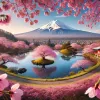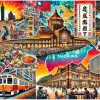Hey everyone, Mark here! I'm back with another adventure, this time from the breathtaking landscapes and spiritual heart of Tibet. This trip was nothing short of extraordinary, and I'm bursting to share my experiences exploring the iconic Potala Palace, the serene Namtso Lake, and the bustling streets of Lhasa. Get ready for a journey that will leave you yearning for your own Tibetan escape!
The Majestic Potala Palace: A Glimpse into History and Spirituality
My journey began at the Potala Palace, a truly awe-inspiring sight. The sheer scale of this palace-fortress is breathtaking. Perched atop Red Hill (Marpori), it commands a stunning view of Lhasa. I learned that it was initially built in the 7th century by Songtsen Gampo, the king of Tibet, but the palace we see today is a magnificent 17th-century reconstruction, serving as the winter palace of the Dalai Lamas and the center of Tibetan political and religious power.
The palace boasts over 1,000 rooms, a testament to its rich history. The name "Potala" itself is a fascinating detail; it's derived from the Sanskrit word "Potalaka," referring to the mythical dwelling place of the bodhisattva Avalokiteshvara (Chenrezig), making the palace a sacred site in itself. The construction was a monumental undertaking, involving thousands of skilled artisans from Tibet, Nepal, and even China under the direction of the 5th Dalai Lama. The sheer amount of manpower and resources involved in its construction is mind-boggling.
A Deeper Dive into the Potala Palace's History and Architecture
| Period | Significant Events |
|---|---|
| 7th Century | Songtsen Gampo builds the initial Potala Palace. |
| 9th-17th Centuries | Palace largely destroyed and in ruins due to wars and natural disasters. |
| 1647-1693 | The 5th Dalai Lama reconstructs the Potala Palace, a project lasting over 40 years. |
| 1994 | The Potala Palace is declared a UNESCO World Heritage site. |
I was moved by the pilgrims making their arduous three-step-bow pilgrimage, inching their way towards the palace, their devotion palpable. The sheer dedication of these individuals was incredibly humbling. The vibrant colors of the palace, the intricate artwork, and the palpable spiritual energy—it all made a lasting impression.
Beyond the Palace Walls: Exploring Lhasa's Spiritual Gems
Lhasa offers much more than just the Potala Palace. I visited the Jokhang Temple, considered the spiritual heart of Tibet and a site of profound significance to Buddhist pilgrims. The temple's history is deeply interwoven with the legend of Princess Wencheng, whose dowry included a statue of the Sakyamuni Buddha, which is still housed within the temple today. The sheer amount of devotion in this historic temple is humbling.
The temple itself is relatively small compared to other temples I have visited, but its spiritual atmosphere more than makes up for its size. The constant flow of pilgrims circling the temple, their murmurs of prayer filling the air, creates a mesmerizing atmosphere that I found particularly touching.
Table Summarizing Key Lhasa Landmarks
| Landmark | Significance |
|---|---|
| Potala Palace | Winter palace of the Dalai Lamas, center of Tibetan political and religious power |
| Jokhang Temple | Spiritual heart of Tibet, houses significant Buddhist artifacts |
| Namtso Lake | Highest saltwater lake in the world, a site of immense spiritual importance |
| Zakyi Temple (财神庙) | Unique temple dedicated to the god of wealth |
The Sacred Namtso Lake: A Journey to the Roof of the World
My journey continued to Namtso Lake, one of Tibet's three sacred lakes and the highest saltwater lake in the world. The drive itself was an adventure, traversing stunning landscapes and challenging high altitudes. The vastness of the lake, surrounded by snow-capped mountains, was simply breathtaking. I have never seen such stunning scenery before. The sight of the yaks grazing peacefully alongside the turquoise waters was a truly magical moment.
The journey to Namtso Lake was just as memorable as the destination. The changing altitudes brought its challenges, and I would advise anyone planning to visit to prepare for potential altitude sickness. The drive itself was memorable with the dramatic views, but be sure to acclimatize!
The Significance of Tibetan Symbols: Prayer Flags, Mani Stones, and More
Throughout my travels, I encountered numerous symbols deeply ingrained in Tibetan culture. The omnipresent prayer flags (Lungta), with their vibrant colors and mantras, are not just decorations, but potent expressions of faith and hope, literally allowing prayers to travel to heaven on the wind. I also encountered countless mani stones, each engraved with the sacred six-syllable mantra ("Om Mani Padme Hum"), which, according to Tibetan Buddhism, brings positive karma and helps liberate you from the cycle of rebirth. Every symbol tells a story, rich in history and spirituality.







